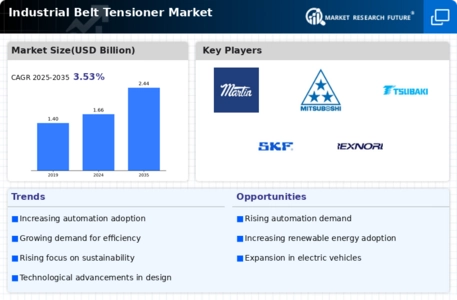Focus on Energy Efficiency
Energy efficiency is becoming a critical focus within the Industrial Belt Tensioner Market, driven by the need to reduce operational costs and environmental impact. Industries are increasingly seeking solutions that not only enhance performance but also contribute to sustainability goals. Belt tensioners that optimize energy consumption can lead to substantial savings over time, making them attractive to manufacturers. According to recent studies, energy-efficient systems can reduce energy costs by up to 30%, which is a compelling incentive for industries to invest in advanced belt tensioning solutions. As a result, the emphasis on energy efficiency is likely to propel the growth of the Industrial Belt Tensioner Market.
Growth in Industrial Automation
The trend towards industrial automation is significantly influencing the Industrial Belt Tensioner Market. As industries adopt automated systems to enhance productivity and reduce labor costs, the demand for reliable and efficient belt tensioners is expected to rise. Automation technologies, including robotics and advanced control systems, require precise tensioning solutions to ensure optimal performance. The industrial automation market is projected to grow at a CAGR of approximately 10% over the next few years, which indicates a robust demand for components that support these systems. Consequently, the Industrial Belt Tensioner Market is likely to benefit from this trend, as manufacturers seek to integrate advanced tensioning solutions into their automated processes.
Expansion of Renewable Energy Sector
The expansion of the renewable energy sector is emerging as a significant driver for the Industrial Belt Tensioner Market. As the world shifts towards sustainable energy sources, there is an increasing demand for equipment that can efficiently manage power transmission in renewable energy systems, such as wind and solar power. Belt tensioners are crucial in ensuring the reliability and efficiency of these systems. The renewable energy market is expected to grow at a CAGR of around 8% in the coming years, indicating a strong potential for belt tensioners designed for this sector. This trend suggests that the Industrial Belt Tensioner Market will likely see increased opportunities as the renewable energy landscape evolves.
Rising Demand from Automotive Sector
The automotive sector plays a pivotal role in driving the Industrial Belt Tensioner Market. With the increasing production of vehicles, there is a corresponding rise in the need for efficient power transmission systems, where belt tensioners are essential components. The automotive industry is projected to witness a compound annual growth rate (CAGR) of approximately 4% over the next few years, which suggests a robust demand for high-performance belt tensioners. Furthermore, the shift towards electric vehicles (EVs) is likely to create new opportunities within the market, as these vehicles require specialized tensioning solutions. Consequently, the Industrial Belt Tensioner Market is expected to benefit significantly from the automotive sector's growth.
Technological Advancements in Manufacturing
The Industrial Belt Tensioner Market is experiencing a notable transformation due to rapid technological advancements in manufacturing processes. Automation and precision engineering are becoming increasingly prevalent, leading to enhanced efficiency and reduced operational costs. For instance, the integration of smart technologies, such as IoT and AI, allows for real-time monitoring and predictive maintenance of belt tensioners. This not only extends the lifespan of the equipment but also minimizes downtime, which is crucial for industries reliant on continuous operations. As manufacturers adopt these innovations, the demand for advanced belt tensioners is likely to rise, reflecting a shift towards more sophisticated and reliable solutions in the Industrial Belt Tensioner Market.


















Leave a Comment